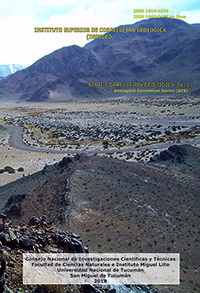Serie Correlación Geológica 34 (2)
Historia evolutiva paleoambiental del depocentro del salar de Pozuelos (Puna Austral).
Verónica Rocío Martínez | Ricardo N. Alonso | Claudia Inés Galli
Descargar trabajo en formato PDFResumen
Este trabajo presenta la historia evolutiva paleoambiental del depocentro del salar de Pozuelos (Puna Austral, Salta. Argentina). El salar, en base al análisis de datos de subsuelo, consta de dos rellenos diferentes separadas por un paleosuelo yesífero, relacionado a la estabilidad tectónica en la cuenca. De base a techo, el primer relleno es de tipo inmadu- ro (facies clásticas o terrosas) que sugiere una depositación ligeramente más húmeda (pero todavía árida) y con mayor aporte de sedimento clástico. El segundo relleno del techo es de tipo maduro (facies evaporíticas o cristalinas), donde las facies evaporíticas son dominantes con escasos sedimentos detríticos, lo que indica condiciones climáticas áridas similares a las actuales en la Puna. Comprende así, un modelo de depositación típico de un ambiente de lago salino, perteneciente al subambiente lago salino efímero y dentro de él se identificaron dos depósitos diferentes y genéticamente interrelacionados saline mudflat y saline pan.
Abstract
PALEOENVIRONMENTAL EVOLUTIONARY HISTORY OF THE DEPOCENTER OF THE SALAR DE POZUELOS (SOUTHERN PUNA). In this paper, it is introduced the paleoenvironmental evolutionary history of the Pozuelos salar depocenter (Puna Austral, Salta. Argentina). In base of different drill holes, two different fillings are recognized and they are separated by a gypsum paleosoil related to the tectonic stability in the basin. The first filling is located at the salar base and consist of immature fill (clastic or muddy facies) suggesting a slightly more moist (but still arid) deposition and higher contribution of clastic sediment. The second filling is located at the salar top and consist of a mature fill (evaporitic or crystalline facies). The evaporitic facies are dominant with minor amount of detrital sediments, which indicates arid climatic conditions similar to the present-day in the Puna. This contribution identified two different and genetically interrelated deposits saline mudflat and saline pan; they correspond to an ephemeral saline lake sub environment. In this context, the described fill of the salar comprises a deposition model typical of a saline lake environment.






